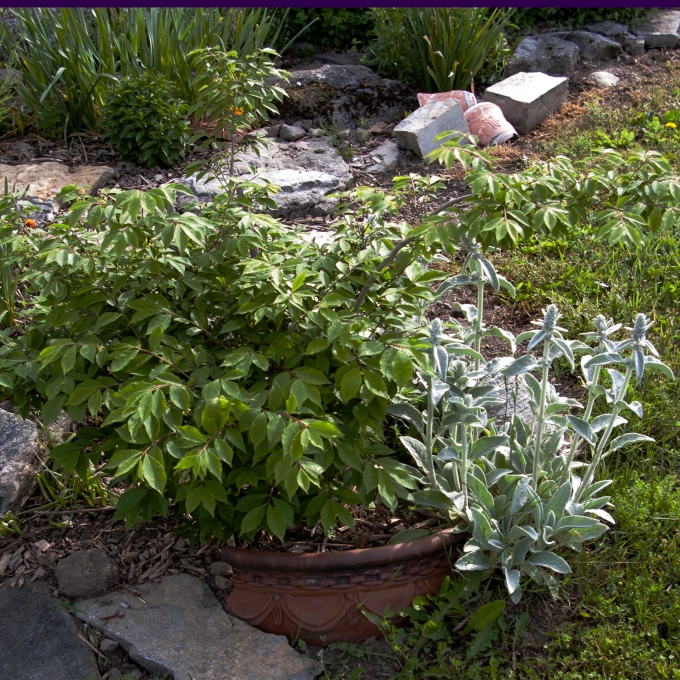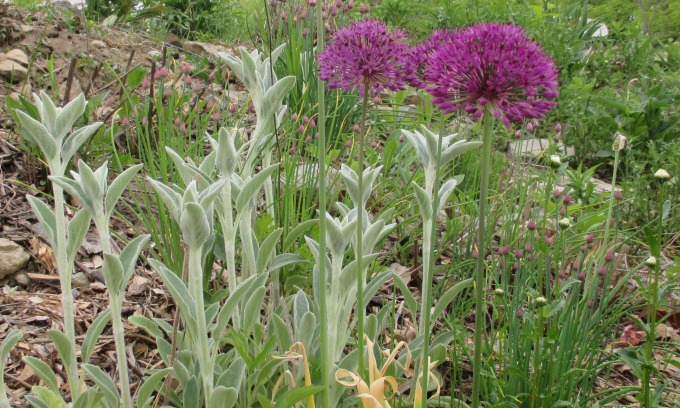

A good friend and wonderful gardener told me last weekend that she cuts off the flower stalks from Lamb’s Ears – Stachys byzantina! I was a bit aghast, but she said she found the flowers a distraction when the main attraction was the soft fuzzy leaves that form a woolly groundcover.
Turns out she’s not not alone – the description of this plant provided by the Missouri Botanical Garden says a lot of people cut off the flower stalks! This practice is common amongst Hosta growers, I know, and I’ve never understood it there either. (Once, I was at a lecture given by a magazine garden writer and she said Hosta flowers are insignificant and should be cut off to let people focus their attention on the foliage. She was a bit upset when I disagreed with her…but that’s another story!)
Hmmmm. I love Hosta foliage, but I also love their flowers – they can be white, lavender, dark purple, sometimes sweetly scented, appearing at various times depending on cultivar. The only downside to Hosta flowers is the need to cut the stalks back after flowering, and Hosta can produce a lot of flower stalks! But the same could be said about a lot of other perennials as well.
As with Hosta, the proponents of cutting back Lamb’s Ear flower stalks contend that by doing so, more energy will flow to the foliage and the ‘creeping stems that root as they go along the ground,’ spreading the plant and making it a true ground cover. They also say because the flowers are so ‘insignificant’ they are of little aesthetic use so just get rid of them!
Again, hmmmmmm. As the photo above shows, the flowers, while small, are really interesting. I love the silky threads that grow all over the flower stalk and complement the fuzzy leaves that make it such a pleasing plant to touch and stroke.
When happily situated (ie full sun, very good drainage such as on a slope, no excessive watering), Lamb’s Ear will spread a lot; if you let the flowers go to seed they will also spread great distances but the roots are fairly shallow and easy enough to pull if they wind up in an unwanted area.
What I learned today? Two things, really.
The first is how it got its name: the botanical name – genus Stachys – comes from the Greek for Ear of Corn – quite appropriate! Byzantina refers to its native range – the Caucasus mountain area of Turkey and Iran.
The second thing I learned, again, from the Missourie Botanical site, is how to pronounce Stachys: it’s like saying ‘stake-ees,’ not ‘stack-iss,’ as I’ve been saying for years!


Never understood the appeal of cutting the lambs ears back either. The more flowers the better according to the bees in my hive 😊
LikeLiked by 2 people
Exactly!
LikeLiked by 1 person
Poor bees. Even tiny flowers are beautiful.
LikeLiked by 1 person
I don’t follow the practice myself as the bees love the flowers. I cut them back afterwards before they set seed. Same with hosta. Some of the bigger hostas have pogoda-like seed heads that last all winter and are quite attractive left in the garden or cut for dried arrangements.
LikeLike
Yes they are attractive over winter. I’ve used hosta for indoor flower arrangements as well, it’s especially nice when they have a bit of fragrance.
LikeLiked by 1 person
I don’t think I could bear to remove any flowers, either.
LikeLiked by 1 person
I still pronounce the letter ‘c’ as ‘s’ in many names just because I think it sounds right; such as Acer and Ceanothus. I do not want to pronounce it as ‘k’, even though I know it correct in Latin. I pronounce Stachys as ‘stasheez’. tee hee. It sounds like a sneeze.
Although I do not cut flowers from stachys, I used to cut flowers from coleus when I grew it as a houseplant. However, once it was set on blooming, it just made more as fast as I could cut them off.
LikeLike
Never heard stasheez before! Love it!
LikeLiked by 1 person
That somehow sounds nasty when someone else says it.
LikeLike
😂
LikeLiked by 1 person